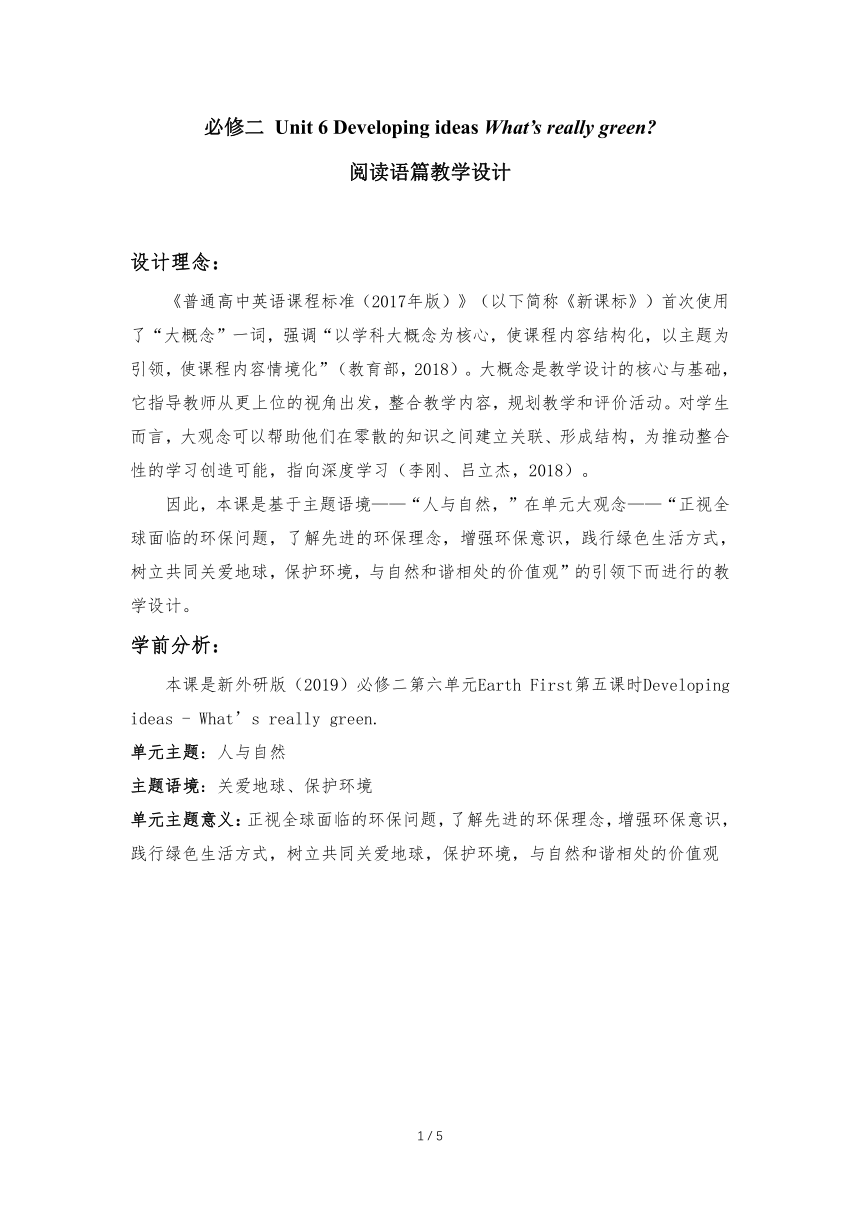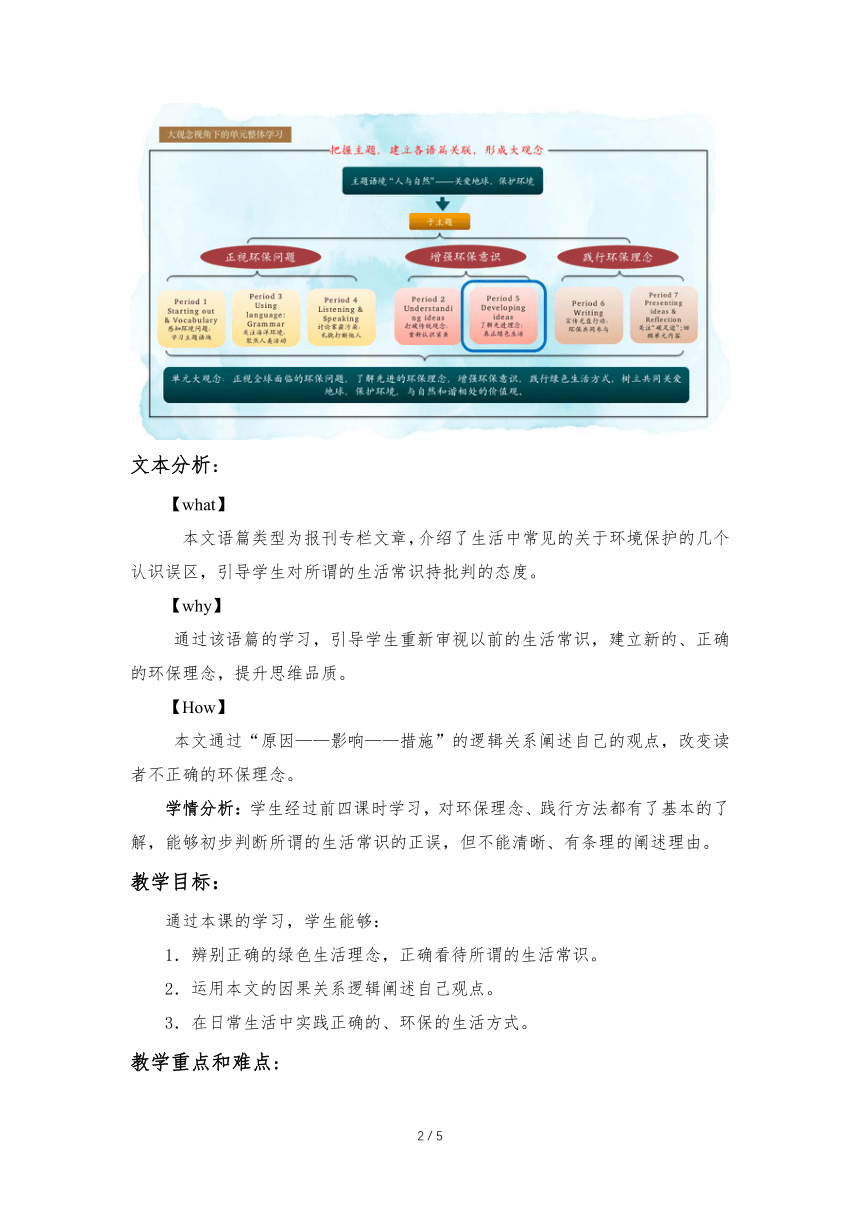外研版(2019)必修 第二册Unit 6 Earth first Developing ideas 名师教学设计
文档属性
| 名称 | 外研版(2019)必修 第二册Unit 6 Earth first Developing ideas 名师教学设计 |  | |
| 格式 | docx | ||
| 文件大小 | 796.7KB | ||
| 资源类型 | 教案 | ||
| 版本资源 | 外研版(2019) | ||
| 科目 | 英语 | ||
| 更新时间 | 2023-03-01 07:26:10 | ||
图片预览


文档简介
必修二 Unit 6 Developing ideas What’s really green
阅读语篇教学设计
设计理念:
《普通高中英语课程标准(2017年版)》(以下简称《新课标》)首次使用了“大概念”一词,强调“以学科大概念为核心,使课程内容结构化,以主题为引领,使课程内容情境化”(教育部,2018)。大概念是教学设计的核心与基础,它指导教师从更上位的视角出发,整合教学内容,规划教学和评价活动。对学生而言,大观念可以帮助他们在零散的知识之间建立关联、形成结构,为推动整合性的学习创造可能,指向深度学习(李刚、吕立杰,2018)。
因此,本课是基于主题语境——“人与自然,”在单元大观念——“正视全球面临的环保问题,了解先进的环保理念,增强环保意识,践行绿色生活方式,树立共同关爱地球,保护环境,与自然和谐相处的价值观”的引领下而进行的教学设计。
学前分析:
本课是新外研版(2019)必修二第六单元Earth First第五课时Developing ideas - What’s really green.
单元主题:人与自然
主题语境:关爱地球、保护环境
单元主题意义:正视全球面临的环保问题,了解先进的环保理念,增强环保意识,践行绿色生活方式,树立共同关爱地球,保护环境,与自然和谐相处的价值观
文本分析:
【what】
本文语篇类型为报刊专栏文章,介绍了生活中常见的关于环境保护的几个认识误区,引导学生对所谓的生活常识持批判的态度。
【why】
通过该语篇的学习,引导学生重新审视以前的生活常识,建立新的、正确的环保理念,提升思维品质。
【How】
本文通过“原因——影响——措施”的逻辑关系阐述自己的观点,改变读者不正确的环保理念。
学情分析:学生经过前四课时学习,对环保理念、践行方法都有了基本的了解,能够初步判断所谓的生活常识的正误,但不能清晰、有条理的阐述理由。
教学目标:
通过本课的学习,学生能够:
辨别正确的绿色生活理念,正确看待所谓的生活常识。
运用本文的因果关系逻辑阐述自己观点。
在日常生活中实践正确的、环保的生活方式。
教学重点和难点:
辩证地看待生活常识
运用本文的因果逻辑阐述自己观点。
Teaching procedures
活动目标 活动形式及步骤 活动意图 深度学习特征 效果评价 时间
Stage 1
激活“保护自然”这一话题的相关背景知识及兴趣,且能够简单概括视频片段的大意。 1. T greets students and introduces the main theme to students, and then invites them to appreciate a video chip called Nature is speaking. 2. T asks students to think about what we should do to protect the environment. 1) What is the clip mainly about 2) In your opinion, which lines impress you most 3. T asks students to finish the quiz in order to see how much they know about a green lifestyle. 1. To arouse students’ interest in the topic. 2. To awaken students’ previous experiences about green lifestyle and lead them to know something new about environmental protection. 活动与体验 学生能够用英文概括视频片段的主要含义。 学生能够说出视频中让他们印象深刻的台词。 学生能够通过小测试反思自己平时积累的关于“绿色生活”的知识。 2 mins
1 mins
1 mins
Stage 2
通过阅读文章标题及小标题,获取文中主旨大意及相关细节信息,并能从文中提取相关信息,从而判断一些观点的正误。 1. T asks Ss to read the main heading and compare the differences between them and think about WHY the author uses “What's really green” instead of “What's green”. 2. T leads Ss to read all the subheadings to figure out the functions of subheading. 3. T asks Ss to read the subheadings in the passage and decide if they are true or false. 4. T asks Ss to read the passage, check your answers and then figure out how these statements go wrong. 1. To train students’ ability of predicting through main heading and subheadings. To train students’ ability to spot the details and integrate this information. To facilitate Ss ability of critical thinking. 获取与梳理 学生能够通过文章标题和小标题预测本文的主旨大意。 。 学生能够找到具体的细节信息,判断正误,辩证思维。 2 mins
1 mins
1 mins
4 mins
Stage 3
通过再读文章,反思之前的环保理念,提升辩证思维能力。 1. T leads Ss to do the quiz again to reflect on their previous ideas of green living. 2. T leads Ss to find out the logic of the passage and summarize the connecting words and expressions. T asks Ss to retell the passage based on a mind map and some key words with the help of the logic and the connecting words. T asks Ss to discover other wrong green truths and explain the reason. 1. To let students rethink the real green living. 2. To let students get the internal logic of this passage. 3. To train Ss’ ability to logically retell a text and explain a statement. 本质与变式 迁移与运用 学生能够辩证地看待之前的生活常识。 学生能够通过思维导图复述文章。 1 mins
7 mins
12 mins
Summary 2 mins
Homework Discover more green truths that are not completely true and explain these ideas by using the causes-effects-measures.
阅读语篇教学设计
设计理念:
《普通高中英语课程标准(2017年版)》(以下简称《新课标》)首次使用了“大概念”一词,强调“以学科大概念为核心,使课程内容结构化,以主题为引领,使课程内容情境化”(教育部,2018)。大概念是教学设计的核心与基础,它指导教师从更上位的视角出发,整合教学内容,规划教学和评价活动。对学生而言,大观念可以帮助他们在零散的知识之间建立关联、形成结构,为推动整合性的学习创造可能,指向深度学习(李刚、吕立杰,2018)。
因此,本课是基于主题语境——“人与自然,”在单元大观念——“正视全球面临的环保问题,了解先进的环保理念,增强环保意识,践行绿色生活方式,树立共同关爱地球,保护环境,与自然和谐相处的价值观”的引领下而进行的教学设计。
学前分析:
本课是新外研版(2019)必修二第六单元Earth First第五课时Developing ideas - What’s really green.
单元主题:人与自然
主题语境:关爱地球、保护环境
单元主题意义:正视全球面临的环保问题,了解先进的环保理念,增强环保意识,践行绿色生活方式,树立共同关爱地球,保护环境,与自然和谐相处的价值观
文本分析:
【what】
本文语篇类型为报刊专栏文章,介绍了生活中常见的关于环境保护的几个认识误区,引导学生对所谓的生活常识持批判的态度。
【why】
通过该语篇的学习,引导学生重新审视以前的生活常识,建立新的、正确的环保理念,提升思维品质。
【How】
本文通过“原因——影响——措施”的逻辑关系阐述自己的观点,改变读者不正确的环保理念。
学情分析:学生经过前四课时学习,对环保理念、践行方法都有了基本的了解,能够初步判断所谓的生活常识的正误,但不能清晰、有条理的阐述理由。
教学目标:
通过本课的学习,学生能够:
辨别正确的绿色生活理念,正确看待所谓的生活常识。
运用本文的因果关系逻辑阐述自己观点。
在日常生活中实践正确的、环保的生活方式。
教学重点和难点:
辩证地看待生活常识
运用本文的因果逻辑阐述自己观点。
Teaching procedures
活动目标 活动形式及步骤 活动意图 深度学习特征 效果评价 时间
Stage 1
激活“保护自然”这一话题的相关背景知识及兴趣,且能够简单概括视频片段的大意。 1. T greets students and introduces the main theme to students, and then invites them to appreciate a video chip called Nature is speaking. 2. T asks students to think about what we should do to protect the environment. 1) What is the clip mainly about 2) In your opinion, which lines impress you most 3. T asks students to finish the quiz in order to see how much they know about a green lifestyle. 1. To arouse students’ interest in the topic. 2. To awaken students’ previous experiences about green lifestyle and lead them to know something new about environmental protection. 活动与体验 学生能够用英文概括视频片段的主要含义。 学生能够说出视频中让他们印象深刻的台词。 学生能够通过小测试反思自己平时积累的关于“绿色生活”的知识。 2 mins
1 mins
1 mins
Stage 2
通过阅读文章标题及小标题,获取文中主旨大意及相关细节信息,并能从文中提取相关信息,从而判断一些观点的正误。 1. T asks Ss to read the main heading and compare the differences between them and think about WHY the author uses “What's really green” instead of “What's green”. 2. T leads Ss to read all the subheadings to figure out the functions of subheading. 3. T asks Ss to read the subheadings in the passage and decide if they are true or false. 4. T asks Ss to read the passage, check your answers and then figure out how these statements go wrong. 1. To train students’ ability of predicting through main heading and subheadings. To train students’ ability to spot the details and integrate this information. To facilitate Ss ability of critical thinking. 获取与梳理 学生能够通过文章标题和小标题预测本文的主旨大意。 。 学生能够找到具体的细节信息,判断正误,辩证思维。 2 mins
1 mins
1 mins
4 mins
Stage 3
通过再读文章,反思之前的环保理念,提升辩证思维能力。 1. T leads Ss to do the quiz again to reflect on their previous ideas of green living. 2. T leads Ss to find out the logic of the passage and summarize the connecting words and expressions. T asks Ss to retell the passage based on a mind map and some key words with the help of the logic and the connecting words. T asks Ss to discover other wrong green truths and explain the reason. 1. To let students rethink the real green living. 2. To let students get the internal logic of this passage. 3. To train Ss’ ability to logically retell a text and explain a statement. 本质与变式 迁移与运用 学生能够辩证地看待之前的生活常识。 学生能够通过思维导图复述文章。 1 mins
7 mins
12 mins
Summary 2 mins
Homework Discover more green truths that are not completely true and explain these ideas by using the causes-effects-measures.
